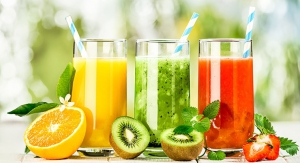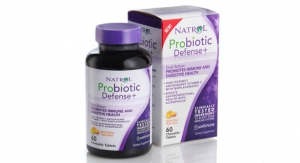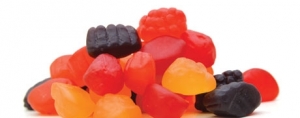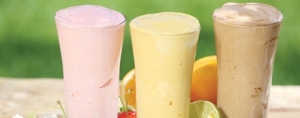Sean Moloughney, Associate Editor07.18.11
As an aging society struggles with vexing health issues like obesity, stress and lack of energy, more consumers have turned to functional foods and beverages to satisfy their thirst for wellness.
Awareness of functional foods is at an all-time high, as 90% of U.S. consumers agree that certain foods have benefits that extend beyond general nutrition, according to the International Foods Information Council (IFIC). Innovation in terms of new product formats, enhanced portability, efficacy improvements and expansion into new categories like confectionery and snacks has helped generate broad interest in the market overall.
Additionally, compared to five years ago, 65% of consumers are more concerned today about the foods they eat, and 56% of consumers are paying a “high” or “very high” amount of attention to food and drink ingredients, according to Datamonitor.
Offering insights on market drivers, Tom Vierhile, director of Datamonitor’s Product Launch Analytics, recently gave a presentation titled “Capitalizing on Evolving Consumer, Product and Ingredient Trends in Functional Foods and Drinks” at the SupplySide East tradeshow in Secaucus, NJ.
Citing the 2010 IFIC “Food & Health Survey,” Mr. Vierhile noted that 73% of consumers said they are looking to add more whole grains to their diet; 72% are looking to add more fiber; and 49% said they are looking to include more protein.
“Taste and price is where the rubber meets the road,” said Mr. Vierhile, acknowledging the lingering effect of the economic downturn and the higher price point for many functional foods. At the same time, however, more people are recognizing the value of prevention, compared to disease treatment, and the need to reign in healthcare costs.
Driving continued purchases in the functional arena, health and good taste are no longer mutually exclusive, Mr. Vierhile added. “Consumers are warming up to the fact that health and indulgence can go together.”
He also noted products aimed at improving general well-being are more popular than those designed to combat specific conditions. Meanwhile, consumers are more interested in hearing what they should be eating, as opposed to what they shouldn’t. “That’s likely because the research regarding what not to eat changes so often,” he offered.
In terms of marketing language, “rich in” has proved more successful than “added,” which has connotations of processed additives. “Consumers are skeptical about the health credentials of processed foods,” he noted.
Major Markets
Reviewing key functional areas, Mr. Vierhile said cardiovascular health has broad appeal, especially in the U.S., where the purchase rate for heart healthy products is significantly higher than the global average. According to Datamonitor figures, U.S. sales of heart healthy foods and beverages reached $5.6 billion in 2009 and are expected to reach nearly $7.1 billion by 2014, representing a compound annual growth rate of 4.8%.
Omega 3s stand out in terms of heart health ingredients, but polyphenols and flavonoids are “rising stars,” as both are found in many types of food, from tea and vegetables to chocolate. Additionally, the number of food and beverage products with resveratrol has tripled, Mr. Vierhile noted.
Representing the second largest functional product category, behind energy products, digestive and immune health products reached $9.7 billion in U.S. sales for 2009. Datamonitor predicts the market will grow 7.7% to $14.1 billion by 2014. “The increasing palatability of products containing probiotics and fiber is driving sales growth in various world markets,” said Mr. Vierhile, also noting growing popularity and mainstream acceptance of kombucha.
Interestingly, U.S. consumers are more interested in immune products (50%), compared to digestive products (32%). Meanwhile, however, nearly 20% of consumers say they have avoided work or social situations due to digestive issues.
As the most mature market, energy products in the U.S. brought in $14.8 billion in 2009, and are expected to grow 6.6% to $20.3 billion by 2014. Consumers simply aren’t satisfied with their energy levels, as 80% say they don’t have enough energy to do all the things they want to.
Growth potential for bone and joint health products is lower than most other functional health categories due to a lack of product innovation, according to Datamonitor. However, joint health is a widespread problem, as 46 million Americans—20% of the population—have arthritis or other rheumatic conditions. In the U.S., product sales reached $3.3 billion in 2009 and are expected to grow 4.4%, to $4.1 billion by 2014.
Cognitive health could be the greatest opportunity in the functional foods and beverages market. While 57% of consumers expressed an interest in cognitive health products, only 19% are actually buying them right now, according to a 2009 Datamonitor consumer survey. U.S. sales could double by 2014, from $1.2 billion in 2009 to $2.1 billion (11.8% growth). “The lion’s share of cognitive product growth is expected to be in the beverage sector, growing at twice the rate of foods in many markets,” said Mr. Vierhile.
Lastly, the beauty foods and beverages category is poised for growth despite a lack of understanding among consumers for terms like “nutricosmetics,” Mr. Vierhile said. U.S. sales reached $76.7 million in 2009, and are expected to reach $133.9 million by 2014 (11.8% growth). Beverages dominate the category, with antioxidants topping ingredient lists and collagen growing in popularity. Datamonitor notes major crossover with the natural/organic market, as 72% of women who buy natural or organic personal care products believe in the “beauty from within” concept, compared to 49% of mainstream product buyers.
Overall, skepticism dampens sales of functional products and companies should look to simplify nutrition labeling in an effort to build trust with consumers. “Make sure front-of-pack marketing is consistent with nutritional details on the back of the pack,” Mr. Vierhile said. Consumers already see fruits/vegetables, fish/seafood and dairy as “functional,” so manufacturers should look to build on what consumers already believe.
Awareness of functional foods is at an all-time high, as 90% of U.S. consumers agree that certain foods have benefits that extend beyond general nutrition, according to the International Foods Information Council (IFIC). Innovation in terms of new product formats, enhanced portability, efficacy improvements and expansion into new categories like confectionery and snacks has helped generate broad interest in the market overall.
Additionally, compared to five years ago, 65% of consumers are more concerned today about the foods they eat, and 56% of consumers are paying a “high” or “very high” amount of attention to food and drink ingredients, according to Datamonitor.
Offering insights on market drivers, Tom Vierhile, director of Datamonitor’s Product Launch Analytics, recently gave a presentation titled “Capitalizing on Evolving Consumer, Product and Ingredient Trends in Functional Foods and Drinks” at the SupplySide East tradeshow in Secaucus, NJ.
Citing the 2010 IFIC “Food & Health Survey,” Mr. Vierhile noted that 73% of consumers said they are looking to add more whole grains to their diet; 72% are looking to add more fiber; and 49% said they are looking to include more protein.
“Taste and price is where the rubber meets the road,” said Mr. Vierhile, acknowledging the lingering effect of the economic downturn and the higher price point for many functional foods. At the same time, however, more people are recognizing the value of prevention, compared to disease treatment, and the need to reign in healthcare costs.
Driving continued purchases in the functional arena, health and good taste are no longer mutually exclusive, Mr. Vierhile added. “Consumers are warming up to the fact that health and indulgence can go together.”
He also noted products aimed at improving general well-being are more popular than those designed to combat specific conditions. Meanwhile, consumers are more interested in hearing what they should be eating, as opposed to what they shouldn’t. “That’s likely because the research regarding what not to eat changes so often,” he offered.
In terms of marketing language, “rich in” has proved more successful than “added,” which has connotations of processed additives. “Consumers are skeptical about the health credentials of processed foods,” he noted.
Major Markets
Reviewing key functional areas, Mr. Vierhile said cardiovascular health has broad appeal, especially in the U.S., where the purchase rate for heart healthy products is significantly higher than the global average. According to Datamonitor figures, U.S. sales of heart healthy foods and beverages reached $5.6 billion in 2009 and are expected to reach nearly $7.1 billion by 2014, representing a compound annual growth rate of 4.8%.
Omega 3s stand out in terms of heart health ingredients, but polyphenols and flavonoids are “rising stars,” as both are found in many types of food, from tea and vegetables to chocolate. Additionally, the number of food and beverage products with resveratrol has tripled, Mr. Vierhile noted.
Representing the second largest functional product category, behind energy products, digestive and immune health products reached $9.7 billion in U.S. sales for 2009. Datamonitor predicts the market will grow 7.7% to $14.1 billion by 2014. “The increasing palatability of products containing probiotics and fiber is driving sales growth in various world markets,” said Mr. Vierhile, also noting growing popularity and mainstream acceptance of kombucha.
Interestingly, U.S. consumers are more interested in immune products (50%), compared to digestive products (32%). Meanwhile, however, nearly 20% of consumers say they have avoided work or social situations due to digestive issues.
As the most mature market, energy products in the U.S. brought in $14.8 billion in 2009, and are expected to grow 6.6% to $20.3 billion by 2014. Consumers simply aren’t satisfied with their energy levels, as 80% say they don’t have enough energy to do all the things they want to.
Growth potential for bone and joint health products is lower than most other functional health categories due to a lack of product innovation, according to Datamonitor. However, joint health is a widespread problem, as 46 million Americans—20% of the population—have arthritis or other rheumatic conditions. In the U.S., product sales reached $3.3 billion in 2009 and are expected to grow 4.4%, to $4.1 billion by 2014.
Cognitive health could be the greatest opportunity in the functional foods and beverages market. While 57% of consumers expressed an interest in cognitive health products, only 19% are actually buying them right now, according to a 2009 Datamonitor consumer survey. U.S. sales could double by 2014, from $1.2 billion in 2009 to $2.1 billion (11.8% growth). “The lion’s share of cognitive product growth is expected to be in the beverage sector, growing at twice the rate of foods in many markets,” said Mr. Vierhile.
Lastly, the beauty foods and beverages category is poised for growth despite a lack of understanding among consumers for terms like “nutricosmetics,” Mr. Vierhile said. U.S. sales reached $76.7 million in 2009, and are expected to reach $133.9 million by 2014 (11.8% growth). Beverages dominate the category, with antioxidants topping ingredient lists and collagen growing in popularity. Datamonitor notes major crossover with the natural/organic market, as 72% of women who buy natural or organic personal care products believe in the “beauty from within” concept, compared to 49% of mainstream product buyers.
Overall, skepticism dampens sales of functional products and companies should look to simplify nutrition labeling in an effort to build trust with consumers. “Make sure front-of-pack marketing is consistent with nutritional details on the back of the pack,” Mr. Vierhile said. Consumers already see fruits/vegetables, fish/seafood and dairy as “functional,” so manufacturers should look to build on what consumers already believe.

























